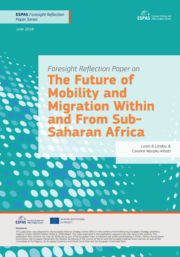
The Future of Mobility and Migration Within and From Sub-Saharan Africa

Through an examination of existing data and drivers of African mobility, this paper suggests there are few reasons to expect dramatic changes in the sources, directions, or nature of migration within and from sub-Saharan Africa. Economic inequality (within the continent and between Africa and Europe), climate change, persecution, and conflict will continue to encourage ever diversifying movements to cities, to neighbouring countries, and beyond Africa. The vast majority of those moving will stay within their countries of citizenship or move to neighbouring countries. About one-fifth of sub-Saharan migrants will seek passage to Europe, Australasia, or North America (the percentage from North Africa is much higher). Although the proportion of Africans migrating internationally may not substantially increase in the decades ahead, the onset of the continent’s demographic boom will result in many more Africans on the move. Ironically, current development investments intended to sedentarize would-be migrants or reduce fertility (and hence the number of potential migrants) are only likely to intensify movements. Looking forward, Europe’s need for labour and its relatively high wages (even if the absolute demand decreases) will continue making it an attractive destination for Africans from across the continent. Increases in African education and experience increase relative earning potential in Europe. Small increases in Africans’ income within the continent will also make possible longer-distance journeys. Given the Middle East’s inability to produce surplus labour of the kind required, Europe will need to call upon Africa as a primary source of migrant labour. Eastern Europe may help ease that dependence, but is unlikely to eliminate it. The report argues that global economic inequality and demographic trends have already ‘locked in’ the general patterns of sub-Saharan African migration for the next thirty years. For sub-Saharan African economies to absorb surplus labour, African states would almost universally need to sustain two decades of economic growth at a pace previously unseen in global history. Moreover, those likely to enter the labour force in the next 15-20 years are already being born or will be in the coming five years. Even if the general trends are likely to continue, three ‘second order’ variables will importantly influence the consequences of human mobility
- Issue:
- Demography, Urbanization and Migration
- Regions:
- Africa, Europe, Sub-Saharan Africa
- Year Published:
- 2018
- Authors:
- Loren B. Landau, Caroline Wanjiku Kihato
- Institution:
- European Strategy and Policy Analysis System (ESPAS)

